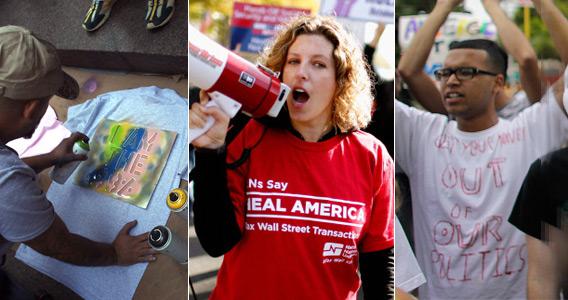The U.S. patent office has received several applications to trademark phrases like “We are the 99 percent” and “Occupy Wall Street.” The anti-corporate movement’s catchphrases represent a potential windfall for T-shirt makers. When did Americans start printing messages on their clothing?
A little more than a century ago. The practice began around the turn of the 20th century, with the increasing popularity of politically branded accessories. Suffragettes, for example, emblazoned the famous phrase “Votes for Women” on yellow sashes. In the 1930s, some alcohol enthusiasts sported scarves reading “Repeal the 18th Amendment.” A few female supporters of Dwight Eisenhower sported dresses emblazoned with the word “Ike” during his 1956 re-election campaign, in one of the few pre-1960 examples of text written onto a main article of clothing. Two major events in the 1960s, however, helped textile sloganeering to become ubiquitous. Andy Warhol’s souper dress, which carried his famous Campbell’s soup print, made it fashionable to wear commercial images, including text. Trendy metropolitan women suddenly began wearing disposable paper dresses printed with candy bar advertisements, Bobby Kennedy’s face, and even the word “Nixon.” Around the same time, an American engineer invented a machine to mass-produce silk-screened cotton clothing. The printed T-shirt became wildly popular in the era’s youth counterculture, and has remained a fashion staple since that time.
This technological advance aside, it’s not entirely clear why it took so long to put words on shirts. Some fashion historians point out that designers were primarily interested in cut and silhouette in the early 1900s. By the middle of the century, however, they had largely run out of shapes for commercial clothing, and fashionistas had to find new avenues to explore. Gucci made prints popular in the 1950s. When Warhol’s began pushing printed words and images into commercial fashion in the next decade, it appears to have inspired avant-garde designers like Sonya Rykiel to experiment with text.
Americans didn’t invent the idea of political clothing, of course. Clothing colors were a popular way for Europeans to publicize their political views in the 18th and 19th centuries. As with gang affiliation, your colors could get you in big trouble. A British member of Parliament told a young political dissident in 1830, “That sash will hang you.”
Embroidered ribbons were a fairly common form of protest in 18th-century England. In 1756, British Admiral John Byng infuriated the public by abandoning a garrison at Port Mahon, forcing one General Blakeney to surrender to the French after a brave stand. Protesters angry at both Byng and the government wore ribbons reading, “Blakeney the brave, vanquished by B–G only.” Another portrayal of the political ribbon comes from a 1780 political cartoon in which a protestant protester—the target of the artist’s wit—sports a ribbon declaring “No Popery.”
According to one apocryphal story, Brits didn’t limit their sartorial sloganeering to weaving and printing. In the 1760s, supporters of John Wilkes allegedly carved the number 45—a number associated with the Jacobite rising of 1745 and a famous Wilkes essay—backward into the soles of their shoes, so that they would leave their slogan in London’s muddy streets.
Got a question about today’s news? Ask the Explainer.
Explainer thanks Jennifer Farley and Melissa Marra of the Fashion Institute of Technology, Ann Frank of Parsons the New School for Design, and Katrina Navickas and John Styles of the University of Hertfordshire.
